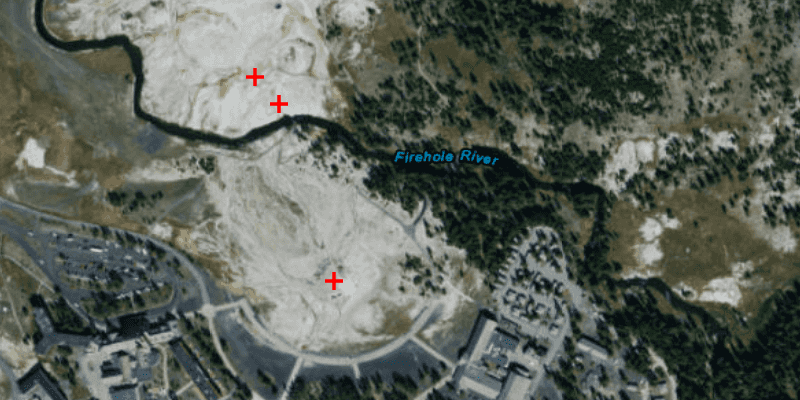Display common symbols for all graphics in a graphics overlay with a renderer.

Use case
Graphics are often used to display data that changes location regularly because they are held in memory instead of being persisted to the map. When a number of graphics are required to share the same style, a simple renderer can be applied to the graphics overlay containing the graphics. For example, the location of mobile taxis from a same company could be plotted on a map with each taxi marked by a relevant symbol.
How to use the sample
The sample loads with a predefined simple renderer, which displays a red cross simple marker symbol for the graphics in the graphics overlay.
How it works
- Create a
GraphicsOverlay. - Create a number of
Pointobjects with x, y and spatial reference parameters. - Create a
SimpleMarkerSymbolpassing in aSimpleMarkerSymbol.Style, color and size as parameters. - Create a simple renderer with
SimpleRenderer(simpleMarkerSymbol). - Set the simple renderer to the graphics overlay using
graphicsOverlay.setRenderer(simpleRenderer). - Create a number of
Graphicobjects with the points initiated in step 2. - Add the graphics to the graphics overlay with
graphicsOverlay.getGraphics().add(graphic).
Relevant API
- Graphic
- GraphicsOverlay
- Point
- SimpleMarkerSymbol
- SimpleRenderer
Additional information
Renderers are used to display graphics that don't already have a symbol set. A renderer will not override a graphic's symbol if one has been set.
Tags
graphics, marker, renderer, symbol, symbolize, symbology
Sample Code
/*
* Copyright 2017 Esri.
*
* Licensed under the Apache License, Version 2.0 (the "License"); you may not
* use this file except in compliance with the License. You may obtain a copy of
* the License at
*
* http://www.apache.org/licenses/LICENSE-2.0
*
* Unless required by applicable law or agreed to in writing, software
* distributed under the License is distributed on an "AS IS" BASIS, WITHOUT
* WARRANTIES OR CONDITIONS OF ANY KIND, either express or implied. See the
* License for the specific language governing permissions and limitations under
* the License.
*/
package com.esri.samples.simple_renderer;
import javafx.application.Application;
import javafx.scene.Scene;
import javafx.scene.layout.StackPane;
import javafx.stage.Stage;
import com.esri.arcgisruntime.ArcGISRuntimeEnvironment;
import com.esri.arcgisruntime.geometry.Envelope;
import com.esri.arcgisruntime.geometry.Point;
import com.esri.arcgisruntime.geometry.SpatialReference;
import com.esri.arcgisruntime.geometry.SpatialReferences;
import com.esri.arcgisruntime.mapping.ArcGISMap;
import com.esri.arcgisruntime.mapping.BasemapStyle;
import com.esri.arcgisruntime.mapping.view.Graphic;
import com.esri.arcgisruntime.mapping.view.GraphicsOverlay;
import com.esri.arcgisruntime.mapping.view.MapView;
import com.esri.arcgisruntime.symbology.SimpleMarkerSymbol;
import com.esri.arcgisruntime.symbology.SimpleRenderer;
public class SimpleRendererSample extends Application {
private MapView mapView;
@Override
public void start(Stage stage) {
try {
// create stack pane and application scene
StackPane stackPane = new StackPane();
Scene scene = new Scene(stackPane);
// size the stage, add a title, and set scene to stage
stage.setTitle("Simple Renderer Sample");
stage.setWidth(800);
stage.setHeight(700);
stage.setScene(scene);
stage.show();
// authentication with an API key or named user is required to access basemaps and other location services
String yourAPIKey = System.getProperty("apiKey");
ArcGISRuntimeEnvironment.setApiKey(yourAPIKey);
// create a map with the imagery basemap style
final ArcGISMap map = new ArcGISMap(BasemapStyle.ARCGIS_IMAGERY);
// create a map view and set the map to it
mapView = new MapView();
mapView.setMap(map);
// create a spatial reference for the points
final SpatialReference spatialReference = SpatialReferences.getWgs84();
// create points for displaying graphics
Point oldFaithfulPoint = new Point(-110.828140, 44.460458, spatialReference);
Point cascadeGeyserPoint = new Point(-110.829004, 44.462438, spatialReference);
Point plumeGeyserPoint = new Point(-110.829381, 44.462735, spatialReference);
// create initial viewpoint using an envelope
Envelope envelope = new Envelope(oldFaithfulPoint, plumeGeyserPoint);
// set viewpoint on map view with padding
mapView.setViewpointGeometryAsync(envelope, 100.0);
// create a graphics overlay and add it to the map view
GraphicsOverlay graphicsOverlay = new GraphicsOverlay();
mapView.getGraphicsOverlays().add(graphicsOverlay);
// create a red (0xFFFF0000) simple symbol for use in a simple renderer
SimpleMarkerSymbol symbol = new SimpleMarkerSymbol(SimpleMarkerSymbol.Style.CROSS, 0xFFFF0000, 12);
SimpleRenderer renderer = new SimpleRenderer(symbol);
// apply the renderer to the graphics overlay
graphicsOverlay.setRenderer(renderer);
// create graphics from the location points.
Graphic oldFaithfulGraphic = new Graphic(oldFaithfulPoint);
Graphic cascadeGeyserGraphic = new Graphic(cascadeGeyserPoint);
Graphic plumeGeyserGraphic = new Graphic(plumeGeyserPoint);
graphicsOverlay.getGraphics().add(oldFaithfulGraphic);
graphicsOverlay.getGraphics().add(cascadeGeyserGraphic);
graphicsOverlay.getGraphics().add(plumeGeyserGraphic);
// add the map view and control box to stack pane
stackPane.getChildren().add(mapView);
} catch (Exception e) {
// on any error, display stack trace
e.printStackTrace();
}
}
/**
* Stops and releases all resources used in application.
*/
@Override
public void stop() {
// release resources when the application closes
if (mapView != null) {
mapView.dispose();
}
}
/**
* Opens and runs application.
*
* @param args arguments passed to this application
*/
public static void main(String[] args) {
Application.launch(args);
}
}